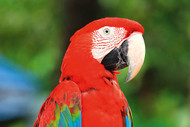Green-Winged Macaw Fact Sheet
Posted by Green-Winged Macaw, Green-Winged Macaw Facts, Green-Winged Macaw Diet, Green-Winged Macaw Behaviour, Fact Sheet on 9/1/2024
Find out more about the Green-winged Macaw.
Scientific name:
Ara chloropterus
Common name:
Red and Green Macaw
Adult length:
90cm
Adult weight:
1.2-1.4kilos.
For everything you need for Green-winged Macaws please click here.
Potential lifespan:
60-65 years.
(It is a myth that large Macaws live to 80 to 100 years.)
Range in wild:
It occurs over much of the northern half of South America, except the eastern area, as far south as Paraguay, also eastern Panama in Central America.
The range of the Green-winged Macaw is still extensive but has declined significantly.
It is already extinct in Argentina and south-eastern Brazil, due to deforestation and destruction of river banks in which it often nested.
A stronghold of this Macaw is the Tambopata-Candamo Reserved Zone in Peru, bounded by the Bolivian border, and created in 1990. I was fortunate to visit the area in 2003.
The clay lick at the Heath River is one of the best places in South America to observe the Green-wing. The lick consists of an exposed bank of yellowish clay about 5m high, topped with tall straggly white-barked trees and lower vegetation. The branches of some of the trees were bare, no doubt stripped over the years by visiting Macaws.

Pet Potential
For someone who can devote as much time to a Green-winged Macaw as they would expect to devote to a child, who has a large house and is not house-proud and who, preferably, is deaf, a Green-winged Macaw might make a suitable companion!
Needless to say, these birds are very large, loud and destructive. The strength of the beak is formidable. For this reason this is not a suitable bird for someone who does not have much experience with large Parrots. The Green-wing has the second largest beak of any Parrot, after the Hyacinthine Macaw.
An owner must know how to handle a large Macaw. By this I mean if the bird has to be caught and restrained for some reason, they know how to hold it. A bite from this species could put you in hospital and cause permanent disability.
Having discussed the negative points, it is only fair to point out that generally speaking the Green-wing has a good temperament, better than that of a Scarlet Macaw. But, of course, individual birds vary.
In general, Green-wings are gentle and affectionate. Like all large Macaws they are highly intelligent and need to be kept occupied with branches for gnawing and toys that are more demanding.
For enriching Green-winged Macaw toys please click here.
A constant supply of gnawing wood (apple branches are good, also large branches of willow) is so important that if you cannot supply it, a large Macaw is not a good choice.
Distinguishing a Young Bird
Very young Green-wings have a shorter tail and the eye is black not yellow. The lower mandible is grey and horn-coloured but has become black by the time the Macaw is one year old. The eye colour turns from light grey, to light yellow to brighter yellow by the age of about three years.
Cage size
This needs to be very large and high. A strong, well designed cage will cost almost as much as the bird. There should be no economising in this area because a Green-wing can destroy all but the very strongest cage.
Many owners of large Macaws build an aviary in the garden or on the patio where they can spend several hours daily, weather permitting. This helps to prevent them from becoming bored.
Click here for Green-winged Macaw cages.
Diet
Nuts are not a luxury in a Green-wing?s diet: they are an essential. Walnuts, almonds and Brazil nuts are excellent (and expensive); pecans and macadamias are also good.
Nuts have been described as the perfect food (for humans) and the fact that some species of Macaws and Parrots eat little else tells us that they are also a perfectly balanced food for these birds.
Nuts have a very high energy content. Depending on the season, many wild Parrots must fly long distances daily to find their food, thus they use up a lot of energy. Our birds use far less energy so their daily allowance of nuts should be rationed, except when used as a stimulus to breeding. A non-breeding bird can be given six or eight walnut-sized nuts daily.
Although nuts are high in fat, Macaws do not gain excess weight because their metabolism is designed for such foods (unlike Amazon Parrots, for example). Peanuts in the shell must be avoided due to the risk of them containing aflatoxins. This can cause fatal aspergillosis and liver disease.
Green-winged Macaws should also be offered a good quality Parrot mixture and plenty of nutritious fruits such as pomegranate, mango, papaya and guava, plus any fresh vegetables they will eat. Berries, such as those of hawthorn and elder, will be relished.

Click here for Green-winged Macaw food.
Breeding
The Green-winged Macaw is firmly established in aviculture but despite the huge numbers imported from the wild during the 20th century, it was not until the 1980s that breeding ceased to be an unusual event.
Clutch size is usually three with an interval of three days between each egg. The incubation period is about 27 days.
Young leave the nest after 14 weeks ? but unfortunately most chicks are removed for hand-rearing, denying the parents the satisfying experience of completing the breeding cycle.
Hand-reared young are gentle, affectionate and sensitive, and must be weaned gradually ? not force-weaned. Total independence of young when weaned at their own pace is in the region is six months.
Click here for everything you need for Green-winged Macaws.

